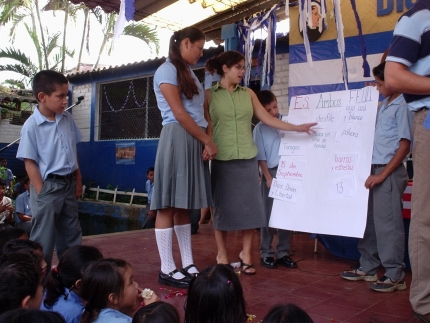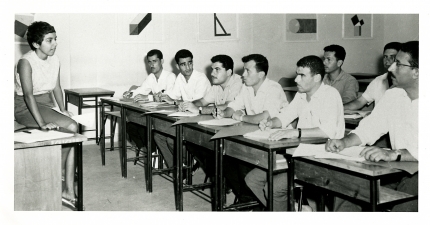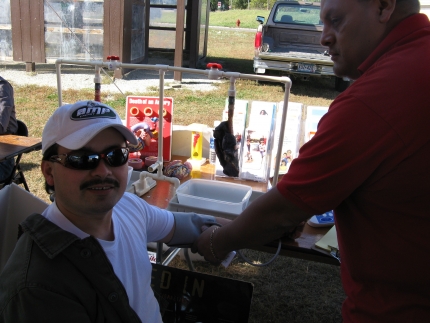Office of Social Innovation and Civic Participation Blog
Sharing Solutions Through Service: A Story Celebrating Service
Posted by on March 17, 2011 at 4:52 PM EDTEd. Note: The Peace Corps program in El Salvador began in 1962 and is was one of the agency's earliest posts. More than 2,100 Americans have served in El Salvador coordinating with local municipalities, NGOs, and community groups to develop better water systems, make health and sanitation improvements, provide environmental education, and assist municipal development projects. Sara served as a Municipal Development Volunteer in El Salvador from 2003-2006.
When I first arrived in Candelaria de la Frontera, El Salvador, I frequently wondered, “Why can’t this country just be more like the U.S.?” Though my family is of Hispanic heritage, I had usually shied away from being labeled as Hispanic and did not regularly embrace many parts of Latino culture. It took me about a year to understand that I had to accept the country with all of its idiosyncrasies, and that if I was going to be there as a Peace Corps Volunteer, I had better work my hardest to make my two-year commitment worth it. So I began meeting with different community groups, helping to strengthen their internal functions and facilitating communication with the local city hall. I organized youth camps, giving many children in my community the opportunity to travel outside of their village for the first time while facilitating educational experiences.
I soon realized that I loved being a Peace Corps Volunteer, and I loved learning about Latino culture, appreciating it, and embracing it. I decided to stay in the country after my Peace Corps service to manage a service-learning program at a private high school in El Salvador, whose students would become future leaders in many fields. The program taught students the value of service by helping them become development workers who learned more about their country by doing hands-on work. On several occasions, I used my Peace Corps community for service-learning activities, and my students led youth camps for children from other Volunteers’ communities.
Working with Salvadorans across the economic spectrum allowed me to learn about Salvadoran society, culture, and different paths to community development. Experiencing the daily obstacles to community improvement in the Peace Corps, and facilitating a student’s first exposure to the stark realities of their country, made me more determined to learn about solutions to poverty; I pursued a Master’s degree in public affairs and learned about solutions on a broader scale. I am now a proud federal employee who strongly believes in the ability of government to provide the foundation for community-level initiatives to address poverty.
I consider the Peace Corps as my launching point for my career in public service, and I am grateful for the grassroots experience that continues to shape my thoughts and actions.
Sara R. Lopez is a returned Peace Corps Volunteer and a Program Specialist in the Office of Intergovernmental Affairs and Partnerships with Peace Corps.
Learn more about ServiceTransformation Starts From Within: A Story Celebrating Service
Posted by on March 16, 2011 at 12:55 PM EDTI went to law school in California planning to make the world a safer place by incarcerating criminals. During my first week, I volunteered to teach incarcerated youth about the law, in all honesty, because I wanted to meet “juvenile delinquents.”
This service experience changed my life.
I realized that underneath the shells of hardened “juvenile delinquents” were kids. Kids who had grown up believing that by the time they were 18 or 21 they would be in prison or dead.
Kids who over and over again would tell me: “If only.”
- “If only I knew how much trouble I would get into.”
- “If only someone had cared about me.”
- “If only I had been given a chance to do something good for community…I wouldn’t be here.”
I hadn’t expected to care. But, their stories began to haunt me. I found myself wishing that someone would listen to their ideas and do something to help. Then it hit me – I should stop wishing and start doing.
So I asked them, “What would you do to help other kids from ending up here?” They said: 1. Teach kids about the consequences of crime to help them learn how to make better choices; 2. Connect them with a positive role model to help them be successful; and 3. give them a chance to give back to their communities to help them show it’s not too late for “juvenile delinquents” to change.
These youth wrote letters of recommendations for seed funding to start Fresh Lifelines for Youth (FLY). Today, over 10 years later, with 100 volunteers and 26 staff, FLY provides the programs they recommended: legal education, mentoring, and leadership training for kids in the juvenile justice system and those at-risk for system involvement. The kids who helped design FLY were right; their suggestions worked. FLY effectively helps kids start transforming their lives for less than 1/10 the cost of incarceration.
At FLY, the youth we seek to serve continue to be our greatest teachers, reminding us that those we want to help have the greatest insights into what they need and an incredible capacity to serve as part of the solution. Personally, I am mindful that being a part of an organization that is all about transformation began, first, with my own.
Christa Gannon is the Founder and Executive Director of Fresh Lifelines for Youth (FLY)
Learn more about ServiceThe View From My Shoes: A Story Celebrating Service
Posted by on March 15, 2011 at 3:04 PM EDTThe captivating power of instant communications, whether it’s Facebook, Twitter, or the 24-hour news cycle, creates the illusion that we are more “plugged in” than we really are. Jolting images of events taking place around the world awaken our sense of compassion and desire for justice. We wish there was something we could do.
Awareness and concern are good first steps. But to truly grapple with the harsh realities that too many people face today, we have to step into their place and literally see the view from their shoes. This is a Peace Corps Volunteer’s vantage point and strength. To “walk the walk” is more than helping to alleviate the painful effects of poverty, conflict, and social discrimination—it’s about advancing the sustaining power of culture and the uplifting complexity of the human spirit.
As a new college graduate, I felt completely primed and empowered to join the Peace Corps as a Volunteer in Iran in 1962. I didn’t realize that the greatest lesson of my life was just beginning. Two years teaching English in a remote area taught me more invaluable lessons than anything else that has happened afterwards. Daily life became transformative just by eating the same food, washing in the same water, and using the same transportation as the people I lived and worked with everyday.
I learned resourcefulness, resilience, and immense respect for a community that gradually learned to accept and trust me as well. The dean of the school where I taught had never worked with a female teacher before; he didn’t quite know how to deal with me at first. Over time I became less of an outsider and more of a valued contributor, and while all my ideas weren’t embraced, many were adapted to fit a distinctly local framework.
What can one person really do? More than you can imagine. Lasting change is best accomplished by small, meaningful steps that accrue and are reinforced over time. And change is never one-sided. By helping to improve the quality of life for others, we create a more meaningful life for ourselves.
I tell students that to really learn about the world, they need to be part of it. Service shapes our values, harnesses our passions, and, most definitely, makes a real difference.
As we celebrate 50 years of the Peace Corps Volunteers, I invite everyone who is ready to “walk the walk” and make a difference in others’ lives to step up and see the view from their shoes.
Donna Shalala served as the Secretary of Health and Human Services for eight years under President Clinton and received the Presidential Medal of Freedom from President Bush in June 2008. She is currently serving as the President of the University of Miami.
Learn more about ServiceHealthy Markets, Healthy Communities: A Story Celebrating Service
Posted by on March 14, 2011 at 12:32 PM EDTAcross the country, many low-income urban and rural communities live without access to the healthy foods that families need to thrive. These areas where residents face economic and social barriers to affordable, fresh, whole foods are known as “food desserts.” At the same time, small farmers are struggling to make ends meet. Wholesome Wave, a Connecticut-based nonprofit, is seeking to nourish neighborhoods and support family farms by directly connecting consumers to fresh foods.
The Office of Social Innovation and Civic Participation had the opportunity to talk with Wholesome Wave. The organization is built on a series of local partnerships and provides solutions that address the nutritional needs of families and build local markets. The staff works with farmers markets and organizations to connect a broad base of consumers to farmers. This three year old organization tells a story of two unlikely partners joining to create a scalable model that addresses the specific needs of people in communities across the country.
In 2008, Michel Nischan, a sustainable food chef, and Gus Schumacher, a former Under Secretary of the USDA, joined to found Wholesome Wave. A professional chef and restaurateur, Nischan adapted his passion for regional cuisine to meet the strict dietary needs of his young sons who had been diagnosed with diabetes. He recognized that the difficulty of achieving a healthy diet for his sons must be amplified for someone without the same elevated access to nutritious foods.
Schumacher’s activism around food access began when he was delivering boxes of pears from his family farm. During the trip, one box fell off the truck. When Schumacher and his brother returned to pick up the fallen fruit, a woman and two young sons were picking the bruised pears out of the gutter. When Schumacher asked why she would be collecting this unwanted fruit, the mother explained that her food stamps weren’t enough to buy the fruits and vegetables her family needed.
The Nischan-Schumacher collaboration was the first of many partnerships that support Wholesome Wave. The organization works with third-party funders to double the purchasing power of SNAP dollars (formerly known as food stamps) when used to buy fresh food at farmers markets. This partnership incentivizes food assistance recipients to choose healthy options without any extra cost. Another project is to develop public-private partnerships with businesses, social services, and public spaces to create Healthy Food Hubs. These are neighborhoods that provide both access to food and information about improving healthy habits.
Since its start in 2008, Wholesome Wave has expanded its programming and reach. The organization has scaled its services from 12 markets in 4 states to over 160 markets in 20 states this year. We applaud Wholesome Wave for the inspiring work they do to serve low-income families and local farmers.
How have you connected your passion with serving your community? Share your story with us.
Divya Kumaraiah is the Policy Assistant to the White House Office of Social Innovation and Civic Participation
Learn more about ServiceUnderstanding the Culture of Questions: A Story Celebrating Service
Posted by on March 10, 2011 at 7:59 PM EDTEd. Note:The Peace Corps program in Mongolia opened in 1991 and has hosted nearly 900 American volunteers over the past twenty years. Volunteer Robert Galloway arrived in Mongolia in 2010 to teach English.
As an English teacher, I’m eager to introduce my students to question words early.
“Yagaad” is Mongolian for “why,” and I enjoy hearing it because such a word really deserves at least two syllables. For a question that so rarely has an answer, just as interesting to me is when it is asked. At home, it was a steady stream of family and friends asking me why I was going all the way to Mongolia for two years. Now that I’m here, the most common conversation I have is, “Do you have a wife, Rob?” “No,” and without a breath in between, “Yagaad?” I used to be taken aback by this; the question sounding to my ears like, “Why, what’s wrong with you?”
My reflections on service are usually based on the small and trivial aspects of my exchanges in Mongolia and the natural human curiosity we hold for one another. In my ninth month here, “yagaad” has slowly been replaced by “why” in my conversations with students, signaling to me that they now expect and desire my answers to be in English. They’ve stopped asking about a wife and started asking about why America celebrates Martin Luther King Day, why I enjoy reading so much, why American families live in the ways that we do.
One of my ninth graders surprised me early on a Saturday morning by knocking on my door: “Good morning teacher, may I chop your wood for you?”
“Really?” I asked, more than a little relieved for the help.
“Yes, I would like to talk and practice English with you.”
“Sure, why not?” I said.
What I’ve come to know is that the Peace Corps is a time when “Why?” becomes “Why not?” both for Volunteers and the people and communities we aim to serve. Each encounter is full of possibility, and the frequency with which I get to answer these questions about myself, and ask them of others, is a small and everyday measure of my impact here—the world becoming a slightly smaller classroom and all of us as students becoming a little more curious about our neighbors.
Why not?
Robert Galloway, 24, is from Wayzata, Minnesota, and serves as an English teacher with the Peace Corps in Mongolia
Learn more about ServiceEmpowering Latinos in Minnesota: A Story Celebrating Service
Posted by on March 8, 2011 at 8:16 PM EDTLocated in Owatonna, Minnesota, Centro Campesino is a grassroots organization that empowers their community members to seek and develop solutions to their problems. The organization focuses on engaging both migrant workers and year-round residents, many who are Latino. Centro Campesino strives to improve the lives of its members through policy reform, education, youth outreach, and advocacy, and empower residents who receive their assistance to become the future providers.
Centro Campesino believes that collaboration with local organizations can enhance the provisions of services. Currently, Centro Campesino is running a pilot program in partnership with Allina Hospital in Owatonna. Centro Campesino staff serve as promotoras or “health romoters” that provide, on a one-on-one basis, basic health education and check-ups. They conduct cholesterol and HIV tests, measure blood pressure, and check sugar levels for community members. Twice a month, doctors from Allina Hospital visit Centro Campesino to provide free consultations to community members who need additional health care. This partnership has created an avenue for patients in the Latino community to receive medical care that would otherwise be unavailable. “The ultimate goal is to eventually open a full time free clinic for low income uninsured residents in southern Minnesota,” says Jesus Torres, a community organizer at Centro Campesino.
Community Outreach Through Youth Empowerment
Centro Campesino also encourages youth to serve their communities through a spring internship program. Students are tasked with identifying problems within the Latino community and developing effective solutions. As an organization devoted to youth involvement within the community and committed to youth education and tutoring, Centro Campesino advocates learning through empowerment. This year the students are directing their efforts toward computer literacy. They have found local sponsors to donate computers, motivated friends and classmates to create a curriculum, and empowered fellow students to teach community members basic computer skills. “Many of those who signed up [for classes] are parents,” says Torres. “It will be interesting to see how these students step-up to teach parents, some of them their own.” Centro Campesino believes that this program will not only prepare youth to be more responsible and to become leaders in their community, but it will also help community members overcome some of the technology obstacles they are facing.
Do you know of organizations or individuals in your community that are rising to this challenge? Share your story with us.
Divya Kumaraiah is the Policy Assistant to the White House Office of Social Innovation and Civic Participation
Learn more about Service
- &lsaquo previous
- …
- 5
- 6
- 7
- 8
- 9
- 10
- 11
- 12
- 13
- …
- next &rsaquo
White House Blogs
- The White House Blog
- Middle Class Task Force
- Council of Economic Advisers
- Council on Environmental Quality
- Council on Women and Girls
- Office of Intergovernmental Affairs
- Office of Management and Budget
- Office of Public Engagement
- Office of Science & Tech Policy
- Office of Urban Affairs
- Open Government
- Faith and Neighborhood Partnerships
- Social Innovation and Civic Participation
- US Trade Representative
- Office National Drug Control Policy
categories
- Blueprint for an America Built to Last
- Equal Pay
- White House Internships
- Civil Rights
- Defense
- Disabilities
- Economy
- Education
- Energy and Environment
- Ethics
- Family
- Fiscal Responsibility
- Foreign Policy
- Health Care
- Homeland Security
- Immigration
- Inside the White House
- Poverty
- Rural
- Seniors and Social Security
- Service
- Taxes
- Technology
- Urban Policy
- Veterans
- Women
- Additional Issues











